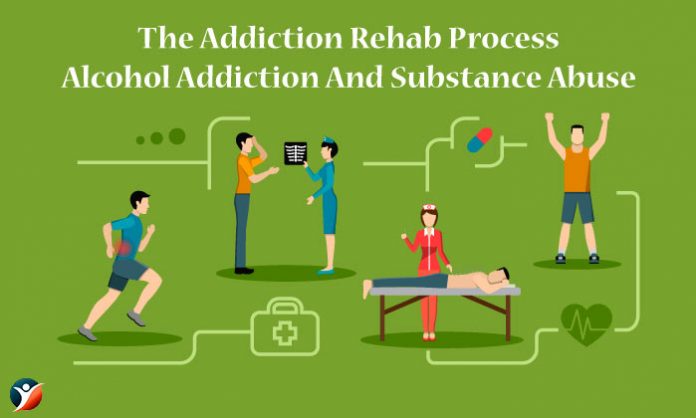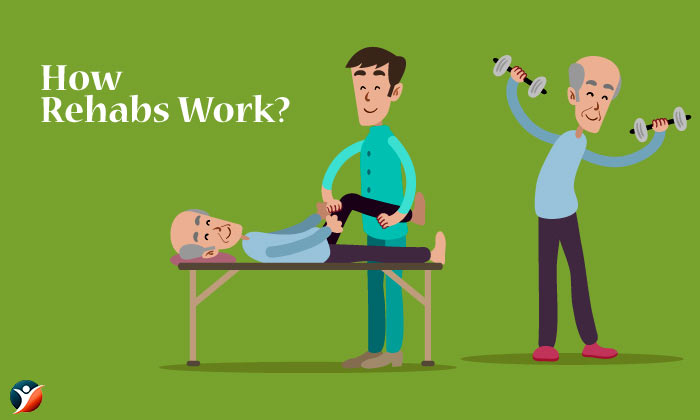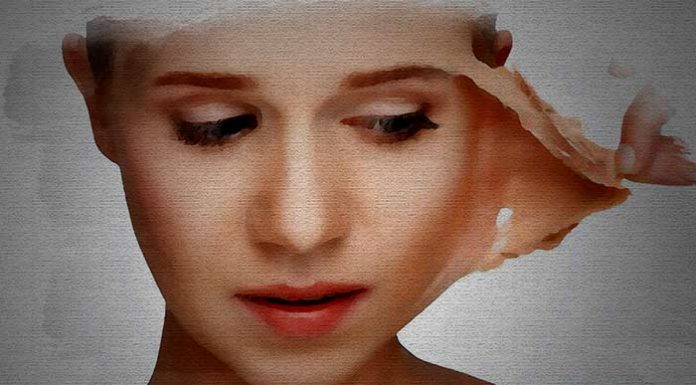
Addiction has an effect on every aspect of a person’s life. Substance abuse can be damaging to career, relationships, spirituality, health. Drug abuse can interfere with a person’s life. So healing is not possible without addressing the underlying issues. By meeting the needs of the patient’s mind, body and soul, holistic treatment for addiction is a more attentive and thorough solution.
Rehabilitation is restoring good health or useful life via therapy and education. Treatment is about applying education, therapy or medicine to attain a positive goal. These two may be used interchangeably but you should know that rehab is the process of change and treatment is specific practice that helps in that process of change.
There is a common saying that You cannot rehabilitate someone who has not been habilitated. So rehabilitation is something that restores someone to a positive level of functioning.
Table of Contents
- How Rehabs Work
- Supportive Rehab Environment
- Various Recovery Methods available at Rehab Centers
- Conclusions
How Rehabs Work?
A first time rehab experience may seem scary but it can also give you the lift you require. The rule is that you can walk out of a rehab anytime you want. Unless you are willing, you cannot be treated. If you enter a rehab knowing that you are going to do drugs again, you are wasting your and everyone’s time.
As drug abuse and addiction have various dimensions that disrupt the different facets of the user’s life , recovery may be difficult. Many times, an effective recovery program will combine together a number of different components. Recovery of the patient goes beyond never using drugs again. It implies having a lifestyle free of drugs and become a functional and responsible member of the society. Research on drug addiction says that in order to overcome addiction and avoid a possible relapse and make a successful recovery, there are many important factors.
Successful drug rehab is about a combination of programs to stop addiction. These programs provide a framework to overcome and combat addiction with a supportive network of others in recovery. Better coping mechanisms are built with therapy and underlying issues can be addressed which cause addiction and problems related to substance abuse. Each of these techniques is powerful and when combined, they form a foundation on which a new substance free life can be built.

Apart from traditional drug rehab methods, holistic treatment incorporates alternative or integrative techniques like:
- Yoga
- Meditation
- Acupuncture
- Herbal medicine
- Nutritional Intervention
- Reiki
- Biofeedback
- Massage
- Exercise
- Physical activities
A rehab is more than a 90 days program. [1] Recovery goes through a series of stages. Detox is the first phase of the program but overcoming the chemical dependence is the beginning of the treatment. Recovering from addiction requires long term commitment in rebuilding the physical and psychological health. The aim of detox is freedom from drugs and alcohol, coping with withdrawal symptoms, and identifying and treating co existing health conditions. You can go through detox at an outpatient center, residential rehab facility, emergency room or hospital. As your body starts adjusting to the absence of alcohol or drugs, you may have withdrawal symptoms and cravings that you cannot tolerate. In a medically supervised setting, you can receive intravenous fluid replacement, nutritional support, pharmaceutical therapy to recover quickly from the withdrawal effects.
Depending on the drugs used by you and the period of addiction, outpatient therapy may be as effective as in patient therapy. Social detox is all about counseling and group therapy so that you can go through the initial phases of withdrawal .
Supportive Rehab Environment
Choosing the right environment for drug rehab is important. Whether you get enrolled in a rehab at an out patient center, inpatient program or residential recovery community, the place you choose should support sobriety.
Drug rehab will be more effective if you do not have social distractions. High risk situations can’t be avoided but rehab will teach you ways to respond to the trigger so that risk of relapse can be reduced and you can feel more confident.
Drug rehab does not make you healthy or sober within days, weeks or months. Recovering from cause and effect of addiction can take a lot of time. If you have a strong network to support you through the process, you can go ahead on a journey which offers challenges as well as rewards.
Various Recovery Methods Available
There are many different types of treatment methods available. Some of them are discussed below:
- Non- Faith Based: It is a treatment that does not refer to a belief in God, rather it is based on evidence for controlling addiction to drugs and alcohol. Although faith based rehab may include treatments apart from prayer- medically monitored detox, proper nutrition, 240 hour care, meditation, exercise, and occupational therapy, non faith based rehab focuses on scientific treatments. The two treatments in non faith based rehabs are:
- Pharmacotherapies: These are maintenance drugs or replacement that can decrease the withdrawal pains during detox like acamprostate, antagonist drugs which make drinking less alluring by curbing the effects of and cravings for alcohol like naltrexone or unpleasant side effects like disulfiram.
- Behavioral Therapies: These treatments alter the attitude of the addict to drugs and alcohol via positive reinforcement, or rewards and teach the patient alternative skills for coping with stress instead of giving way to drinking. These therapies include Cognitive Behavioral Therapy (CBT), community reinforcement approach, contingency management, motivational enhancement therapy.
Aftercare plan is important after any treatment. Remaining sober during treatment is comparatively easy. But when a person goes back to its old association and life, the desire to drink may increase. So the post rehab program should include medical visits, individual and group psychological therapy, and support from family and friends.

- Faith-Based Therapies: There are some people struggling with addiction who get the strength from faith. This is more about relying or depending on God and using spirituality. People who have religious beliefs are better off with people who share those beliefs. Many people feel that spirituality is a comforting mechanism, which gives them solace. Belief is important in faith based programs. The aim is to use religious and rehab option to have a life free from dependency and enjoy a better life. When a program is based on faith, the patients can overcome the dependence by using power of spirituality and relying on God. The belief is that a power greater than the individual can help with the problems. This is because it is thought that dependency not only affects the body but also the mind and is also suggestive of a spiritual crisis. The importance of spirituality comes from the fact that a person needs someone greater or higher than themselves to overcome their struggles. This idea may not be accepted universally but it influences people who come from a devotional background. Studies show that spirituality helps people feel positive emotions and is beneficial to the health.
- Holistic/Biophysical Treatment: Biophysical refers to solving biological problems using physical methods. And there are many alcohol treatment programs that treat addiction with more drugs, these treatments address addiction using a biophysical and holistic approach.
Using drug therapy to rescue a person from addiction may result in relapse and many people resist drug therapy due to contradictions. Biophysical treatment understands this and follows a different approach:
- Natural Healing principles and drug free applications
- Unique detoxification for removing residues of drugs
- Healthy foundation for complete recovery
- Residential therapy programs and long term inpatient programs.
Biophysical approach is safe and more effective. After getting free of the substances post detox, patient’s mind becomes clearer and he/she is in a position to tackle the psychological aspects of addiction and understand how to remain free from alcohol and drug abuse. Apart from treating the withdrawal symptoms there are many benefits of biophysical treatment:
- Nutritional supplements used during detoxification can help in rebuilding the body
- Sweat therapy helps remove toxic waste from the tissue
- Education to imbibe a sense of responsibility
- Follow up to ensure success
Traditional programs treat withdrawal symptoms with more drugs, never really giving the chance to fight addiction and restore natural health. The most effective treatments are customized according to the type of addiction and people. Rehab centers with biophysical approach acknowledge this disparity and ensures that patients remain sober and safe in their journey to true recovery.
- Drug Replacement Therapy: This controversial method of recovery uses drugs to relieve a person from addiction. A very important example is that people addicted to opioids are prescribed methadone.
- Cognitive Behavioral Therapy: This focuses on the fact that overcoming addiction and maintaining sobriety over long term is more than just going cold turkey. It is about getting rid of unhealthy behaviors and stopping the dependence on illegal substances to bring positive changes.
The two main components of CBT are functional analysis and skills training. In functional analysis, the therapist works with the patient to identify feelings, circumstances and thoughts which are experienced by the patient before and after using illicit substances. This will assist the patient in identifying choices and risky behaviors that can lead to relapse. It also gives insight in to why the patient uses drugs or alcohol in the first place.[2]
In skills training, the patient will unlearn the destructive habits and form new ones . It is believed that the patient may have turned to drugs because of reasons like: Did not learn effective strategies to deal with adult life challenges. This is particularly true of people who started substance abuse early in life. Drug abuse will weaken the ability of using effective strategies. This method of treatment is time limited, so unlike other methods, it does not have a never-ending approach. Since CBT is effective in short time, it is an attractive approach [3].
-
- Dual Diagnosis: This describes patients who have an issue like mental illness and a simultaneous dependence on alcohol or narcotics. There is a complex relation between the two. Those who have both at the same time need a more intense treatment than someone who suffers either one.
- Non 12 Step Rehab: Whereas some of the programs are spiritually centered, the alternative methods are about self empowering and personal responsibility. This is a personalized method which adapts according to the patient rather than the patient adapting to it.[4]
Conclusion
Most of the addiction treatments have abstinence as the goal. Relapse doesn’t mean that you should give up on the patient. Addicts have their ups and downs and you must take this information and learn how to do better with it. Around 50% of the patients remain sober for at least one year after the treatment and those who relapse do not go into a black hole. Instead they return to the treatment/rehab for relearning the behavioral skills they learnt the first time.




